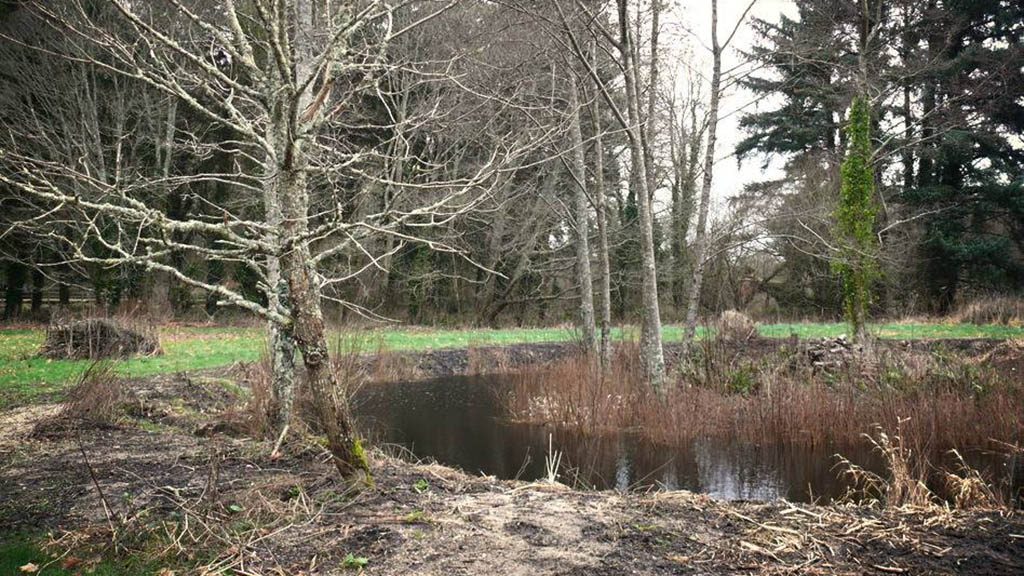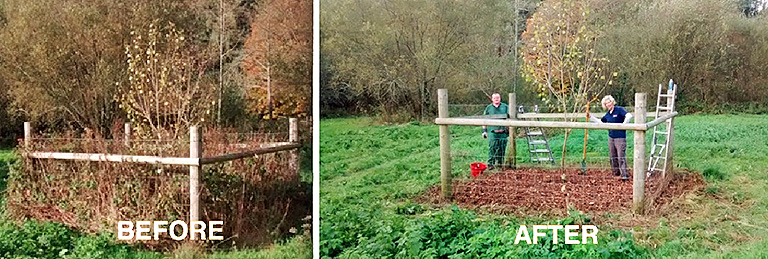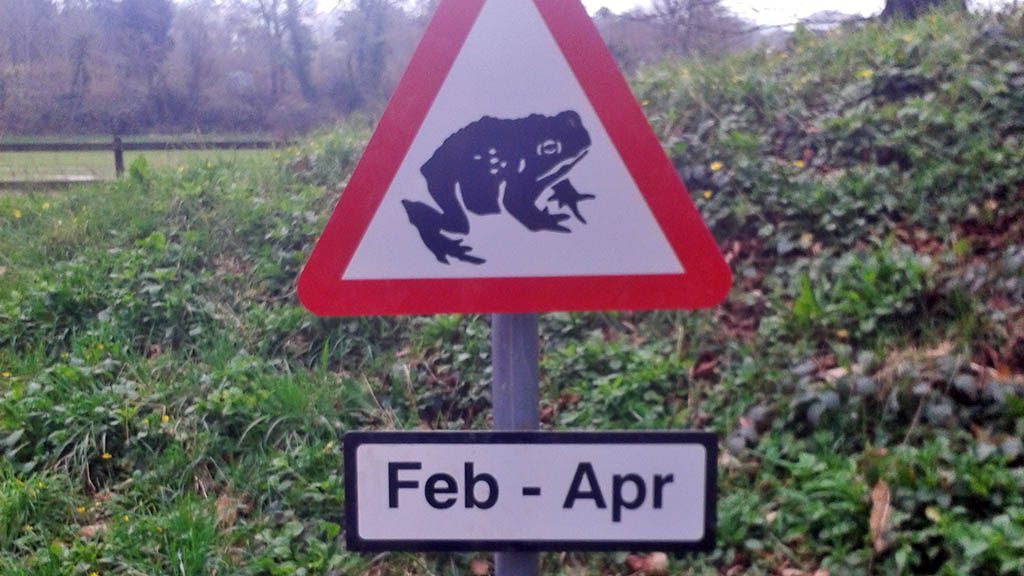At the entrance to the estate, from the lodge to the start of the cycle track on the Lower Drive, there is a causeway that dissects two wetland sites. On the lodge side you have Queen’s Marsh and on the opposite side you have Berryman’s Marsh.
Berryman’s Marsh is classed as a wetland – large varied set of habitats that are covered in water for a considerable part of the year. They provide a mosaic of flooded and unflooded grassland to attract a variety of different species.
The heart of the wetland is marshy grassland with various wet meadow plants like meadow sweet, purple loosestrife, hog weed, hemlock water dropwort and water mint flanked with an avenue of mature oak trees lining the River Dart. On the opposite side of the marsh you’ll find willow, alder and young oak acting as a screen from the road and a cover for wildlife. There is a block of mixed woodland with a mixture of spruce, pine, ash and sycamore. We have a half a dozen bird boxes which are mainly frequented by blue tits.
There are two fairly large relatively shallow ponds in the centre of the marshy grassland which were created in the early 1990s. There is an interesting story how these ponds were created by a contractor who was doing some drainage work in the marsh: Stephan Harding, ecologist and Schumacher College lecturer, persuaded the contractor to excavate two ponds in the centre of the marsh in return for a bottle of whisky!
The willow and the alder were coppiced around the ponds several winters ago to allow more sunlight in to help oxygenate the ponds, to reduce the amount of leaf litter falling into the water, and to help prevent the ponds silting up in the future.
In November 2016 a thin layer of silt was scraped out of the ponds with an excavator by a local contractor. This was undertaken to enable the water in the pond to run more freely and become less stagnant.

Three clumps of willow in front of the viewing platform were coppiced this winter. This management was undertaken to open up the marsh to reveal the rare black poplar enclosed in the tree guards in the distance, on the far side of the grassy marshland.
A male and a female cutting were kindly donated to Dartington and were planted in 2012 to commemorate the Queen’s Diamond Jubilee.
The black poplar – Populus nigra – is thought to be Britain’s most endangered native timber tree and has been in decline for the last 200 years. The Crown Estate has been taking cuttings as part of conservation attempts to preserve the tree.
Black poplar are classed as a medium to large deciduous tree, can grow up to 30 metres tall and can live for a couple of hundred years. The bark is dark brown in colour but can appear to look black with cracks and fissures and the twigs are quite lumpy. The leaves are heart shaped and glossy green, and the young ones have tiny hairs which are shed in the autumn.
The black poplar is dioecious which means the male and the female flowers are on separate trees. The flowers are catkins – the male red and the female yellow-green – and are wind pollinated. It tends to grow in low lying areas of wet ground like Berryman’s Marsh. Black poplar trees a hardy pioneer species – one of the first species to colonise open areas because of their rapid growth rate. These trees are good for wildlife as it is the food plant for many moth caterpillars like the poplar hawk and hornet moths. The catkins provide seeds for the birds to eat and are an early source of pollen for bees and other insects.

Once the trees were coppiced the thinner braches were placed into brash piles and the thicker logs were stacked into habitat piles. These will provide homes for wrens, robins and other birds and field voles and many other creatures. Toads will also use them to shelter from the elements where it is nice and warm and safe from predators. The cut vegetation is used in this way to enhance the wetland habitat rather than burnt or put through a wood chipper so no part of the tree is wasted.
Willow is a quick growing tree and tends to favour and flourish in wet ground. It can grow roughly a metre a year. Willow is great source of food for insects and can support several hundred different kinds of insect. The only other tree that comes close to supporting that amount of insects is oak. Generally it is good practice to coppice the willow on a 4 to 5 year rotation so the willow is at different heights and at different growth rates. This in turn creates a mosaic of habitats rather than just one age of habitat. Different invertebrates require the willow and scrub to be at different age rates.

Another type of tree which can be found growing in Berryman’s Marsh is alder –Alnus glutinosa. Like willow, their natural habitat is on boggy land and on riverbanks. In high rainfall areas like Devon they tend flourish in damp clay soils. They are a short-lived tree, usually to around 150 years. Alders are classed as a medium-large tree growing to approximately 20 metres. They are a rapid growing tree and grow just under a metre a year. Like the willow, alder can be single stemmed or multi-stemmed due to their ability to produce ‘suckers’.
Alders produce catkins and cones. In the spring they display yellow catkins and the empty cones are unique feature in the autumn and winter. The trees support and host many different types of insects and lichens too. The goldfinches are attracted to its cones in winter.
Alders are beneficial species to plant where the ground is liable to flood. It is able to withstand many weeks with its roots under water. They are effective for screen planting and hold on to their leaves until late autumn.
In late spring the ponds will be planted up with aquatic marginal plants, and floating and submerged oxygenating plants will be placed into the pond as well.
Recently we erected toad crossing warning signs on the Lower Drive, one each end of the causeway. In the past, toads have been killed crossing the road between Queen’s Marsh and Berryman’s Marsh, so we want road users at certain times of the year (between February and April) to be alert to this. Common toads usually migrate back to their ancestral breeding ponds each year. The toads tend to follow the same route each year, which occasionally leads them to crossing roads and getting squashed by motor vehicles.

A recent study by Froglife using data collected by ‘Toads on Roads’ volunteer patrollers has shown that on average common toads have declined by 68 over the last 30 years in the UK.
Froglife are in the process of applying for a Heritage Lottery Fund grant to fund a ‘tunnels under roads’ scheme across Great Britain. The tunnels will be installed where there is a high concentration of breeding toads in wetland nearby. If Froglife are successful with their funding bid Dartington could potentially become a research site. The tunnels could be installed underneath the causeway providing safe passage for the toads under the Lower Drive.
Soon, we will also be starting to renovate and improve Queen’s Marsh as wetland habitat for birds and other forms of wildlife associated with wetlands. More on that to follow!
Mike

It might be an interesting area to run some moth traps one night in the summer and I’d be happy to do that if it was of interest.
Hi Richard,
We are always happy to welcome new members to our amazing Conservation Volunteers, particularly when it supports capturing knowledge and information about the biodiversity of the estate.
If you could fill in the Volunteer Interest form online http://dartington.org/support-us/volunteer-hub/volunteer-interest-form/
Then we’ll arrange for you to meet with Mike and get you set up.
Loving the info on Poplar and Alder and I love the idea of toad tunnels too. Great work Mike.
Thanks for all the hard work and care Mike. Great to see everything growing and changing. i’ve lived at the bottom of the drive area for 30 years and have walked in the woods that long too. Its my home!
if we have any sightings of otters would you like to know? There were a couple at the bottom of the weir at the beginning of March but non seen since.
Debbie
Hi Debbie,
Please do let us know if there are any otter sightings! As much as possible we try and keep records of all the wildlife on the estate.
The other people to tell would be the Devon Biodiversity Record Centre and they’ve made it very easy with a phone app http://www.dbrc.org.uk/tell-us-about-your-sighting/
The great thing about registering your sighting with the DBRC is that the recorsd are then widley available to ecologists, both locally and nationally, and contribute to a bigger picture understanding of the state of wildlife in the UK.